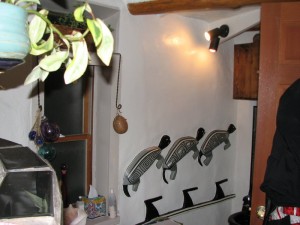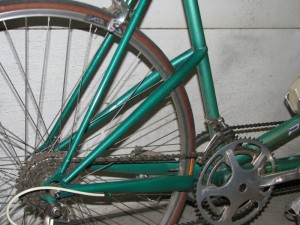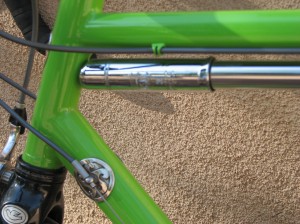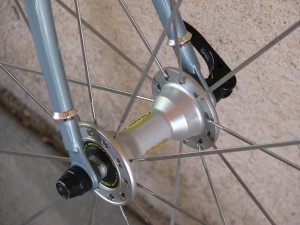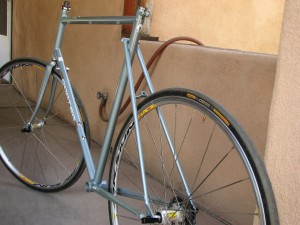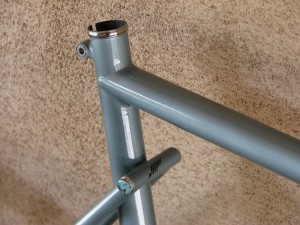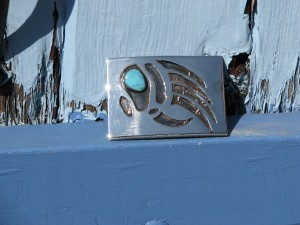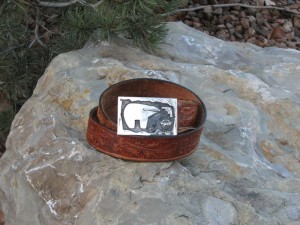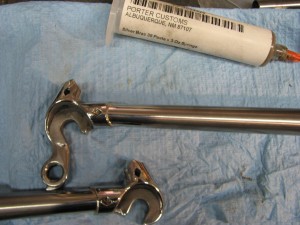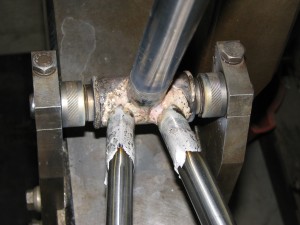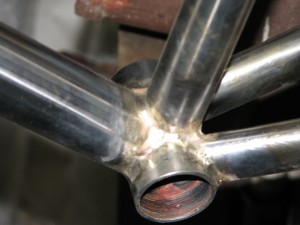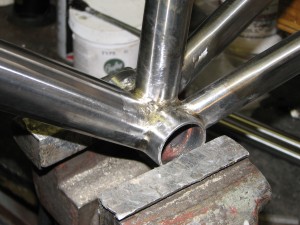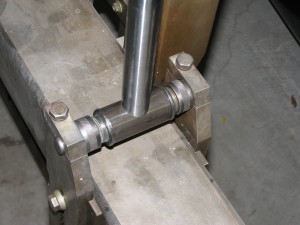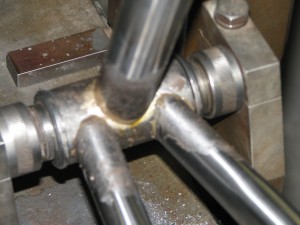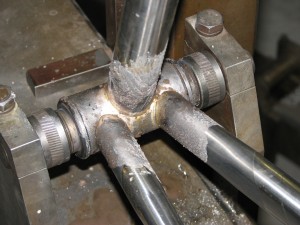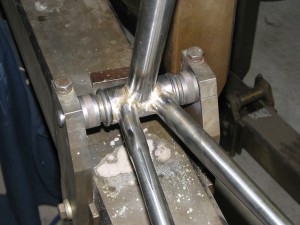It’s been a year since the last tandem was finished. It was a success that, fortunately, matched my expectations, but being a track tandem it was a financial nightmare. Link to that build here. Like unicycles, the market is really small and the fixie group hasn’t decided they all need a tandem to round out their collections. So, I just spent another $800 bucks for this pile of very new steel (well, Niobium) tubes from Columbus. There are a couple odd balls, like the round Cromoly boom tube a 9/6/9 (that’s frame builder speak for the wall thickness of a butted tube, er, the ends and the middle).
There are 5 Columbus down tubes used for the down tube, top tubes and the laterals. Normally they are 0.5/0.38/0.5mm for the Spirit road set. These are .6/.38/.6 So just a smell more beef at the ends and this should be the cat’s meow for a tandem application. Bear in mind that this is going to be a

Raw ingredients-stir and bake at 1200 degrees
geared road version with no intention of loaded touring.
Honestly, I’m swamped with automotive work and hopefully now that I’ve put this up for the world to see, it will push me to get started on the work I love the most and take a break from the work that pays the bills every month. ;~)
Before I forget, again, here’s a picture, nearly an optical illusion, of one of the Columbus Spirit (shaped- not that round Over/Size “for lugs” stuff the other guys are using)
As you can see it is oval-ized at the ends but the oval rotates from vertical at one end to horizontal at the other. One can also see the 8 sides. It is a marvel of tubing design, should such a marvel interest one…

At the heart of the matter
By the way, a comparable Carbon Fiber down tube of equal length weighs about 50 grams, these weigh 60 grams..
With all the talk on the various frame-builder forums and chat lists about how to lay down the perfect fillet, try one or two of these on for size. It ain’t in Kansas anymore..
For anyone wondering, I’ll be using Fillet Pro silver based filler for 98% of the joining. Great product, available here http://www.CycleDesignUSA.com hope that link works..
OK let’s get this show on the road…
I spent an entire day trying to decide what to do with some of the design elements to come. Chauncey came by and then re rehashed the whole project over again and I finally drilled and tapped a couple new holes in the jig to lengthen the boom tube another one inch. It’s up to 650mm c/c now..

preparing jig for tandem build
Remember, click on photo to enlarge and use return arrow to return to text..
So here are the front eccentric and the rear (stokers) BB shells loaded in the jig and drilled for brazing vent holes.

Choosing the boom tube
Well, I had wanted a full length oval boom, but was unable to get one in a timely fashion so I bought a round 9/6/9 mountain bike down tube at 750mm but, it was too heavy and I couldn’t make myself like it enough to use it, so during the process of wasting the afternoon I found this slightly surface rusted Columbus MAX OR down tube, also 750mm long and I was just informed by a reader that the OR down tube is also 9/6/9. It is perhaps half the weight and oval-ized at both ends. Bonus!
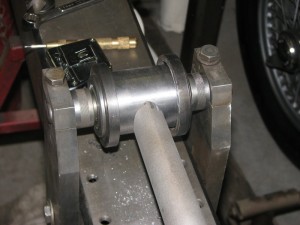
front BB and boom tube
So I blasted it, mitered it and then did the other end..

rear BB shell and boom tube
here’s the cold fit look.

cold fitting-pre brazing
It’s time to give a plug to my collaborator from the last tandem.. Thank you Mr. Martin Manning! Part of the reason I wasted so much time was deciding on some of the attributes I’m hoping for from this more versatile bike. So Martin and …well, it was mostly all Martin,. He made some insertions and changes to the track tandem drawing with his Bike Geometry program. (What a cool tool and its free!) I know there are some other programs out there to design with, but this one is very, very bicycle specific and Martin is so into bike design.
So, this is out of sequence, but here’s the 1 1/8th” head tube at it’s 74.5 degree angle. What? Yes, it’s going to have a 1″ steel, but thread-less steerer. I like steel and I like to decorate it with silver. Get over it.. Builders note: Turns out that the thread less plan didn’t pan out as expected. It’s a threaded one inch steerer with a Cane Creek mod 100 doing the work load and a Nitto adapter for the stem adapter.. end note.

74.5 degrees
OK, time to get some more heat (and fumes) in the shop. It hasn’t been above freezing here for the last 2 days.. So, here is what I did for the second time. I’ve loaded the ID of the boom tube with 38 percent silver paste. This after coating with flux. The paste has its own but I found that more is better to get the 38% to move a little better. The point here is to create an internal filet at the same time I’m building the external filet..

silver paste "Butter"
Moving right along now..

eccentric post filet
so, here’s the “keel” backbone,

partial "keel"
next the chain stays. And lastly today, while Chauncey was here, he did some practice welds with the TIG on some stainless, like these, except these are mine… not very clear and probably just as well and anyway I don’t think I’ll ever TIG weld a bike frame

TIG'd stainless w/o filler practice welds
So today’s project was to get some work done on the chain stays, specifically the dropouts attached, but no, I out smarted myself. I bought another set of the cast adjustables like I last used on the Mini-MAX frame a few months back. Well, it was a nice idea, but there is no way, short of S-bends in the stays to get the 140mm spacing needed for this tandem. Oh! How about Keith’s new Tito drops… well, they will bend, but they are a little too short for that and then to still have the finished look I would have wanted. Darn. So, without too many tears I went to the trusty file cabinet and found a suitable set of forged Columbus horizontals… here’s the choices.. (several days later: This just in from one of my growing list of guardian angels, Wayne on the Hobbs Tandem list tells me that the new “conventional” rear axle spacing is 145mm and wider still for Santana tandems- so much for convention ;~) )

Decisions-decisions
And here is the brazed up stays and drops. I’ll file these next so I don’t have to do cleanup work after the seat stays are in the way to impede access to all surfaces. After they cool, I keep an old coffee maker next to the bench and soak the flux off with hot water, then give them a run through the wire brush whirligig. It would be nice to just leave them in this semi-organic state, but the forgings are so rough I have to file them smooth for painting. Some may wonder what the big deal is here, well my “signature” seat stay attachment can make the connection at the drop look awkward due to the more acute angle.

Ready for detailing.
It’s late, but I’ll get these up now and explain later……(yawn) morning all. OK- I managed to cut the chain stays to length (430mm) and form the miters at the BB connection (70mm drop). These are triangular shaped stays from the old Columbus EGO sets. These, sadly, were the last two in stock at Nova Cycles warehouse stash. The next sets are going to be difficult to find. I have to drill vent holes in the BB shell and I think I’ll put a couple in the distal ends too. It’s pretty dry here in NM, but generally warm enough to ride throughout the winter months and that means that condensation can be a problem when returning to a warm storage spot or the frame could end up in wetter climes. These stays are closer to Nivachrome or Chromoly so they don’t have the rust resistance that the new Niobium has.

Chain-stays mitered to BB

Dropouts in road drop fixture @ 140mm
Just a shot of the drops loaded into the road drop fixture. It has shims to achieve the desired axle spacing and removable set screws to set the side to side indexing so the drops are at the same angle. There are also some pre-set holes to add rack bosses in the usual spots.

cog-scallop
I like this picture. Simple beauty. Enlarge. (click on pix)
Moving along again after a couple “just touch” with a file as my late friend Pino would have said. The rear axle spacing is up to 145mm and the chain stays are brazed and semi finished. No point in doing too much finish work until the seat tube, guides and whatever are attached as well. Here’s the picture..

left side
It’s back in the jig again. Normally I’d do the front down tube next, but I’ve decided to add the set or sets of seat stays next. This means the stokers seat tube must be positioned, so I’ll get after that..
I got the stokers seat tube attached and the primary set of seat stays ready to attach at which time my feet, which I’d already been on for 12 hours in the “other side” of the shop were telling me to call it a day. I just want to point out in the following picture the unusual shape of the Spirit seat stays. They start as the usual round taper at the dropout and then have teardrop/wing sort of 6 1/2″ long section and reverts to round again. The OD is nearly 11/16ths, which is down right big as compared to other manufacturer’s stays. It adds a goodly (technical term) amount of strength.

Shaped seat stay
Building old fashioned steel frames is a pile of work and at some points in the process there are aspects that appear to the uninformed observer as ugly.. some of this next group of pictures is were the process is between the raw weld and semi-finished. To get to the full paint ready condition takes the majority of time. Gross pipe fitting is gratifying to the builder because he/she knows that the weld is correct and that the location of the part is where it should be-sometimes not an easy task. This is more so when lug less frames have no spigots to make the job easier.

Stoker BB
Here the stokers BB is on the 4th weld, the seat post. It still has one more when the rear lateral is added. At each stage I do some shaping of the fillet and removal of the used flux and oxides of combustion that stain the surface.

Niobium and silver
Here’s a real close look.
This next shot is the “signature” seat stay connection before any shaping. This joint was done with 56% silver filler. I need the filler to easily flow into the joints with out overheating the tubes. A balancing act with the torch..
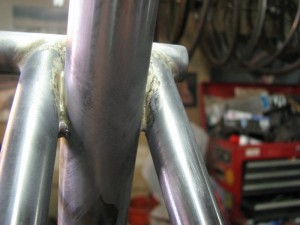
Seat tube and seat stays
The non drive side rear drop is interesting as one can see a tiny piece of scrap that I’d inserted in the weld gap to hold the drop at the precise angle. Some folks use pins or nails or other means. This is easy and effective for me..

Rear drop out
..and here’s the other side..

Columbus horizontal dropout
Now that the rear triangle is attached, I’ve attached the brake bridge. It’s not the one I wanted to use, but after searching the shop for the tried and true Cinelli 506’s for an hour I said what the hell, so I turned this one upside down (I guess- no brake bridge police that I’m aware of) and I’ll doll it up with something when I get to that point. This is also 56% filler.

Brake Bridge

A bit fuzzy
Here’s the mid-seat connection after a little work with a round Riffler file. Looks better already. Darn digital camera gets fussy about focus with out doing the Macro setting which is too close for getting the whole object and the regular way gets too busy with background stuff..then there’s the flash prompt..geeze.
keeping things moving, I’ve attached or more aptly pre-placed the captain’s seat tube. Here I loaded the ID with silver paste and heated until it bonded with the eccentric shell. This will keep overlap welds to a minimum while the main downtube is being fitted.

Captain's seat tube
I had the chance to buy a full size alignment table from a local builder and the price was good. I don’t really think I’ve had much use for one in the past as my Morroni jig doubles as an alignment fixture, but it can’t hurt to have another nice usable tool. I added casters to it so I don’t have to dedicate too much precious space.

Bringheli Alignment Table
Here’s a new trick. These tubes are really hard to scribe a center line on since the diameter changes constantly from end to end relative to the center line. So what I do is use a carpenter’s chalk line and snap the line. It’s by eye, but that ‘s pretty good. See the blue?

Thin Blue Line
Tonight I cut the main down tube to length and mitered the ends. Spent most of the evening trying to decide the seat tube lengths and placement of the internal laterals. I don’t have a drawing so I’m using my experience and how I think it will look the best.. it’s a personal thing, functionally it’s moot.
Now here’s a couple cuts that you won’t see too often. I do this pretty much by eye. I’ll hold the top tube more or less in place and using a Sharpie draw the perpendicular outlines of the seat tube. Then with a hole saw followed with the trusty Dynafile cut the top and bottom of the top tube where the seat tube will (hopefully) intersect. The rusty old seat tube is just a way to gauge my progress in the vice until, as below.. and from the side
and from the side

gross fitting stage
and lastly tonight, here’s the front half with the main down tube brazed in place. At this point the remaining top and lateral tubes won’t be brazed in place until they all fit and look pleasing to the eye.

New and old
I didn’t get a whole lot done on the frame tonight. I managed to get the rear lateral within an inch of where I want it. The captain’s top tube is also close, but the stoker’s top tube is just sitting on top of jig held on with a toe strap!
I received an old Raleigh in the parcel delivery today. It was bent sideways at the seat stays and I wanted to get the repair done and off my plate, so that ate up some time and I dismantled some of the new alignment table. I was very unhappy with the BB post’s method of setting the shell and the cylindrical jack was several thousandths out of perpendicularity (there’s a mouthful, eh?). Drew G. at the other end of the country recommended buying brass tipped set screws for the head tube “precision bar” so it wouldn’t be scarred with every tightening. I opted for flowing a drop of silver on them, same but different. Good idea Drew. Thanks! Nevertheless, I’ll add one more picture..

Starting to look like a bike
I forewent a bike ride on a darn nice winter day today because this frame was calling to me. Right now I’m in the stage that is tedious and slow, thus requiring a weekend afternoon without distractions. Well, all the main tubes are cut and mitered and ready to prep and braze, except for the internal lateral joint on the captain’s seat tube. The Spirit is very thin walled and I will cut some half tube shims to beef up the joint. They are “buried” in the fillet and unseen. So more hand mitering to open the circumference there. (I don’t feel there is any need to repeat that with the seat and top tube since it is effectively reinforced with the seat post.) You can see in the next picture that they sag a little there because its not a close miter and they are sitting on a c-clamp.

Main tubes all in place
This shouldn’t cause anguish, but I didn’t like some of the decisions I’d made along the way. I really need to get this sold, I don’t need another tandem, though one fellow on the Classic Rendezvous list admitted to having eight. It is now a 58.5cm captain seat tube and a 56cm stoker. I wanted a little smaller in the rear, but I reasoned that since the stoker doesn’t have to put their foot down at every stop it would still be an acceptable compromise.
So after cleaning the tubes and lathering with flux I brazed them into place. It’s a done deal now, eh? It’s a Federal holiday today, so I have a legitimate excuse to work on the frame and not on the cars backed up in the driveway, plus it could reach 60F today and it’s time to get back into a 5 day a week riding schedule.
I’ll do some filing on the new welds and try to decide how to address the open ends of the two top tubes at the captains seat, With the MAX I used to continue the tube to the other side then add a flat cover panel. But, here I have 4 flat surfaces just begging for some shiny silver decoration.
Now I remember why its been a year since the last one. They are a boat load of work. I put 10 hours of filing and shaping the fillets in today. My right hand (dominant) was the worst burned in the fire of ’07. The web area required grafting and has always given me some grief, but I must say that spending multiple hours with a Riffler file exercising the thumb and fore finger is excellent therapy. Good thing, as there are still several days of similar finish work still to come.
I’m very happy with my welds, only two small spots that were not fully to the height of the rest and required going back to fill.. The most difficult was the rear seat/BB/Lateral joint. If you can imagine the thick wall BB and the near paper thin Spirit tubes and then try to flow the silver on the underside of the lateral as it miters into the BB and boom tube. A typical temperature flame will rapidly overheat the lateral and burn it and too cold it will never flow out on the BB or boom. Solution was to flow the under side of the boom first then adjust the flame to a super oxygen hot with a very short flame, which won’t wash over a large surface area, but rapidly heats the thick wall tubes and flowed the silver down very nicely.

All main tubes brazed and shaped
I took a bunch of photos of the individual joints but the flash and reflections made them unusable. Maybe tomorrow with some day light I’ll try again.
The next step is to fill the gaping holes on the top tubes, which I mentioned yesterday. Unfortunately tomorrow is a work day, so maybe tomorrow evening.
Finally had a chance to work on the frame a little tonight. I need to go back and do more shaping on a few of the fillets. Tonight I decided to get after the internal laterals where they butt to the captain’s seat tube. The front lateral is shorter than the rear, consequently the diameters and shape is a little different where they butt. So, the major shape was obtained using silver, but tonight I filled some of the low and mismatched spots with lead filler. I like the lead because it goes down at about 300 degrees F. It’s very soft and easy to shape with a file. I also don’t need to worry that flexing of the frame will crack it off, like Bondo or glaze might. Here are a couple ultra close ups. So close the file marks from the jewelers files look like canyons. The lead is slightly darker than the steel. The yellow is the silver. These still need some emery and then primer and blocking will take care of the rest..

Right side

Left side
I felt like I left this subject hanging last night, so I took a few moments this morning to finish/sand the joint with 320 grit cloth and hit it with some flat black rattle can to see where I am in getting it looking like I want.
These tubes do more shape shifting and have more metal contours than I usually deal with. Anyway, this is getting close and I’ll just switch to a glaze to eliminate any visible feathering.. The lead is really superior to plastic fillers but, it requires another level of supplies and expertise.

Left side-pre blocking

Right side pre blocking
I decided that the ends of the top tubes were not going to fix themselves so I cleared the bench of the heavy tools and pulled out the jeweler’s stuff. I’m running low on some of the silver sheet and I’m running low on ideas.
I decided that a nice silver Oso (bear) fetish would look OK on the cover, then I decided to do an overlay, then I changed my mind and decided to put a stone bear over the silver overlay and antique-ish the edges. Well, after nearly a half day of messing around I have this..

Captain's seat back
For the head badge I decided to keep it pretty simple. All silver.

Head tube badge
I see its been six days since I added any content to this posting, But I have been hard at work on this tandem all those days, well nights at least. I have worn my fingers thin sanding and re-sanding and then re-sanding a couple more times. I haven’t bothered with glazing putty for ages and for good reason. It will make you crazy trying to fill every file mark or imperfection. That’s why they’re “hand made” for Pete’s sake. Anyway, its as smooth as I’m going to do. The braze-on’s are on and most of the silver work is on. I didn’t post pictures of this as its pretty rote stuff. I’ll finish the last silver bit tomorrow and then get after the fork. I can see the light at the end of the tunnel. Yah!
Here’s some pictures without any explanations..

Lesft side with blocking showing

End caps and silver bridge work

Front to rear perspective

Headbadge

Bottle bosses

Last turquoise piece for the stoker
It’s been below 10 degrees F for the last two days, very unusual for Albuquerque and way too cold to work on cars, soooo I went to work on getting the fork done. here’s the steerer and crown while still warm..

Crown and steerer joint
As I mentioned earlier in this article, I am collaborating with Martin (Bicycle geometry 101) Manning. He has suggested a rake which results in 45mm of trail. I must say that I’m a little concerned. I’ve never built a fork with so much rake/offset as this one has. I was always happy with the handling when the trail was between 2 and 2 1/2 inches . This is about 1 7/8 inches of trail. Martin’s theory is that this will impart more low speed stability. One has essentially twice the force on the lever arm created by the trail, which makes tandems hard to handle at start-up and when climbing a steep hill. Those situations are hard enough due to the rider coordination required. They go fast, too, so the high-speed stuff can’t be ignored. He believes the better compromise is to accept a little less stability at high speed in favor of the low speed operation.
Here’s the blades loaded in the jig with 47 mm of offset..

fork jig
And lastly today, here is the finished fork in the frame…

Frame and Fork
OK, time to think seriously about paint colors..
Well, after about two seconds of consideration and the fact that I have a full can of the green I painted my own bike with, here it is, awaiting components. Signal green Imron frame and fork…

front triangle and fork

back to front view

seat stays with turquoise

The whole enchilada
That about wraps this up. I’ll get it assembled as soon as I get all the “stuff” and then post a few pictures and an evaluation of its performance.
This project took over a month to complete and that was working on it very nearly every day. I haven’t decided on pricing yet, but no doubt it will be less than the effort expended.
Stay tuned in…













